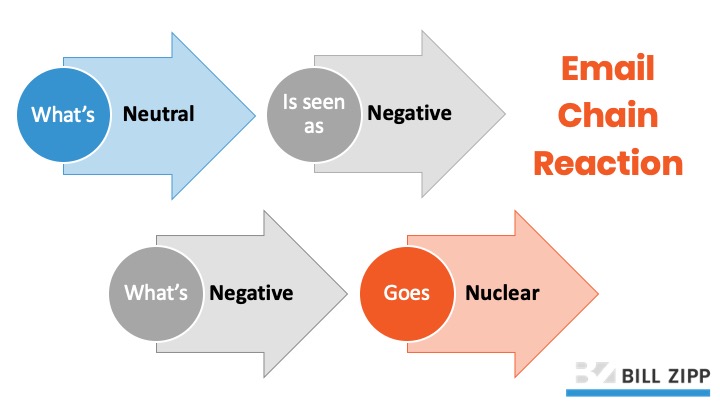It was 4:00 a.m.
I’d been tossing and turning since 2:00 a.m.
The source of my sleeplessness was an email I received before going to bed many hours earlier. In it, a colleague mentioned in passing some slight I’d served him and that comment got under my skin.
By the time 4:00 a.m. arrived, this aside had amplified in my sleepless mind into a full-blown violation of my basic human rights. I was incensed!
So I grabbed my laptop and pounded out a sharply worded, extensively documented email and sent it to every person on the planet. Then I went back to bed.
I awoke to utter humiliation and weeks of apologies. I still cringe when I recall that embarrassing episode.
Neutral, Negative, and Nuclear
We’ve all done something like this. (Maybe not as epic. When I make a mistake, it’s always big and bold.) What we often don’t realize about the medium of email is the chain reaction it can initiate. Because written communication lacks the emotional cues that real interaction with human beings provides, it can be tone deaf.
The same goes for texts and Twitter.
Here’s how this chain reaction occurs. What appears to be a perfectly neutral correspondence to the sender of an email (or the writer of a text or tweet), without supportive emotional cues, can be perceived as negative. Additionally, statements that are slightly negative, like the critical comment in the evening email I received, can devolve into a full-blown nuclear meltdown.

As corny as it sounds, always remember to be nice in your email. Nice short circuits the neutral-negative-nuclear chain reaction. This involves saying please and thank you and providing a word of praise or an encouraging comment. These simple courtesies inject humanity into your communication, preventing it from being seen as something other than it is and deepening loyalty to your leadership.
In addition to this piece of “nice” advice, here are three warnings to heed. Don’t use email this way. Ever!
WARNING ONE: Don’t Send Email Under the Influence of Adrenaline
The great advantage of email, of course, is its immediacy. We can’t imagine a time when we waited a few days for a letter to arrive, let alone a week. “Snail mail” we call it with a sneer.
Immediacy is also one of email’s great weaknesses. There are times, especially when issues are tense and relationships strained, when a few days, or even a week, is exactly what we need before engaging in a conversation.
Here’s why.
One of the first things that happens in a tense situation is our emotions sense danger, and adrenaline, the brain’s emergency response system to danger, surges through our veins. That surge of adrenaline makes us more focused, more intense, and more prone to act aggressively to protect our turf.
Under the influence of adrenaline, we say things or do things that we regret. Emotional intelligence guru, Daniel Goleman, refers to this as “emotional hijacking,” and it’s an apt image. Emotions charge the cockpit of our brain, taking over the controls and crashing our relationships into the ground.
When an impulse to send a sharply worded email that puts someone in his or her place comes over you, let wisdom be your guide. Do nothing. Don’t send a thing. Get control of your emotions; then, and only then, address the issue at hand.
WARNING TWO: Don’t Correct via Email
A second warning to heed regarding email is: never use it for correction. Not that you shouldn’t correct others as a leader. That’s not the case at all. Just don’t use the medium of email to do it.
Again, here’s why.
Correcting people via email is efficient but not effective. It’s efficient because, as a busy leader, you’re able to check an item off your things to do list, zipping off a well-worded rebuke and getting on with your day (or night). The problem is that you can’t control the context in which that email is received. And context is everything when it comes to correction.
Consider these possibilities:
- The person who receives your email may have just been given bad news, like losing their biggest account or having a child rushed to the doctor, and your correction rubs salt in the wound.
- The person who receives your email may read it quickly between meetings and miss your point entirely.
- The person who receives your email may read it over and over and over again, becoming obsessed with the slightest shade of a word or phrase, losing all perspective and objectivity.
- The person who receives your email may share it with others, making your private correspondence a topic of public conversation.
When you correct via email, you don’t intend for any of these things to happen, but they do all the time, as effectiveness is sacrificed on the altar of efficiency.
When you need to provide correction as a leader, control the context of the communication as much as you possibly can with a live conversation in private. While this may take a little more time than writing a quick email, it will save countless hours of painful misunderstandings.
WARNING THREE: Don’t Allow Email Replies to Get Past Three
We’re all familiar with these email functions: forward, reply, reply all, copy, and blind copy. And we know established protocols related to them. Copy only those who need to be copied with an email. Never use blind copy, it’s deceptive. Only reply all when truly, everyone on that list needs to be included in the conversation. The same applies to forward.
When it comes to hitting the reply button, however, there’s one more protocol to follow. Don’t do it more than three times in an email string.
I arrived one morning for a series of coaching sessions with the executive team at a client company. Before getting started on my day, the HR Director took me aside and showed me a printout of the email correspondence of two executive team members. The stack of paper was nearly ten pages long, single spaced. Reading from the back to the front, each ensuing email was longer and more intense than the one before it.
Warning One was ignored, as both leaders were writing under the influence of adrenaline. Warning Two was ignored, as well, since the printed pages were full of personal attacks. But before any of this happened, if Warning Three had been followed, the other two warnings would have never been violated.
When you move your cursor to hit reply for a third time in an email string, stop. Email is not working any more in this conversation. It’s time to talk. Make a phone call, set a meeting, pop into a person’s office, but don’t try resolve the matter by email. It’s not going to work, and, in fact, it will probably get worse.
Email isn’t going away any time soon. Business leaders send and receive 168 pieces of it in a typical day, and that number is on the rise. Texting, too, is increasing in day-to-day work settings.
This means there’s a lot of opportunity for nuclear meltdowns that can undermine your leadership. Be nice. Be wise. Don’t correct—reserve that for in person, private interactions. And most of all, take the time for real conversation.
Unless, of course, you want to find yourself awake at 4:00 a.m. in the morning, anxiously tossing and turning. But I don’t think you do.


